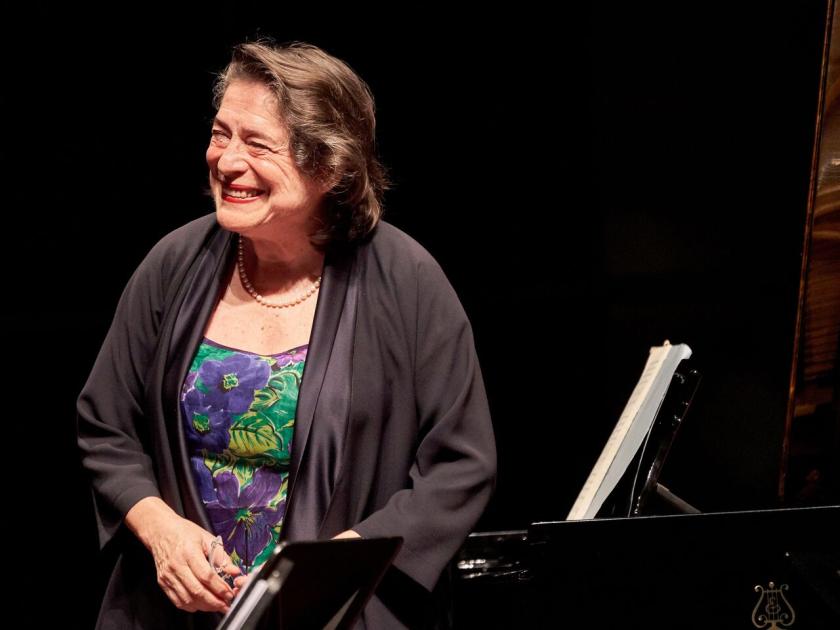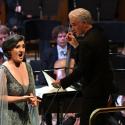“What is it about Mozart?” wondered the legendary pianist Sviatoslav Richter, pointing out the composer's frightening demands of accuracy and lucidity. Even though many pianists today command technique to spare, a Mozart fear factor tends to keep his sonatas off recital programmes. Richter’s longtime protegée Elisabeth Leonskaja once made a disc with him of arrangements of late piano sonatas but she is now more associated with the epic romantic repertoire that she is playing around the world for most of this year, Beethoven, Brahms, Tchaikovsky, and the great Schubert sonatas.
So an evening of four Mozart piano sonatas of 1783 is one surprise – still more their interlacing with two little jewels of piano music beamed back across centuries from the atonalists, Schoenberg and Webern. Nearly 130 years from Mozart’s middle period to Schoenberg’s Six Little Piano Pieces of 1911, over 150 to Webern’s Variations Op 27 of 1935. Even a full century on, today’s audiences still have not really got used to the Second Viennese School, a second front of fear (and perhaps a reason for the less than full house).
Richter instinctively linked Webern and Mozart via their translucencyThere’s more connection between these composers, though, than just Austria. Richter linked Webern and Mozart instinctively: Webern’s music was “of such translucency that, in spite of its complexity, you immediately notice if even so much as a single note is missing. The same is true of Mozart.” This is also generally true of Schoenberg’s atmospheric miniatures, apparently crafted from as few notes as possible.
Perhaps a bold palate-cleansing exercise, in the middle of a year playing dozens of more grandiose piano exhibits, was what inspired this fascinating Wigmore Hall programme from the ever-inquiring Leonskaja, who has paired Berg with Beethoven in the past. The 1783 sonatas, K 330-333, are all in major keys, which makes for some great crunches as centuries collide: Wolfgang’s blithe moods face up to Anton’s haunted ones, classicism’s heartbeat hits Arnold’s arrhythmia, and the harmonic hierarchy of the diatonic scale meets shadows where 12 notes lurk equally.
The mix was fresh, exhilarating to hear – perhaps also disconcerting for a pianist whose playing is naturally large and deeply textured. Leonskaja made quite a few left-hand slips in the sonatas (which she played from memory, unlike the later pieces), as if this snapping of aesthetic logic was a stern reminder of how not to take a single thing in “easy” Mozart for granted.
Four Mozart major key sonatas is a lot of sunshine, and it is hard with modern ears to imagine how their delicate threads worked out on early pianos where notes died so quickly. The deceptively simple writing often comes down to a singing top line with harmonic colour in the left hand, an inviting space which your own aural imagination orchestrates. Such barebones composing is not naturally compatible with the huge, reverberant sound of the Wigmore’s Steinway, and the opening C major sonata began lustily, even robustly.
But then the sunny uplands burst with birdsong and glistening arpeggios, and Leonskaja showed her scintillating finger skill and deployed her exceptionally graceful coordination of power from the back. You could see her physically working to rein in the volume of the Steinway beast, while evoking the cheekiness, mystery moments and curlicues of fantasy that Mozart creates with his dapples of blue notes. These sonatas contain surprise after surprise, and once in a while her daring didn’t come off, alas! Left-hand harmonies occasionally slipped her memory, K332's final bottom note was silent, the cadence unfinished. This just made Mozart’s challenge all the more fun.
The Steinway had been magically transformed into a delectable little travelling band of dulcimers, cymbals and drums
By the close, the famous “rondo alla Turca” of K331 (she took the sonatas out of order), the Steinway had been magically transformed into a delectable little travelling band of dulcimers, cymbals and drums, amusing and charming.
Meanwhile the brief layerings of Schoenberg and Webern were provoking almost opposite questions, such as why have time signatures if the music ignores them, or why have notes at all, when the spaces between them are so tense? The Schoenberg pieces of 1911, each about a minute long, are just as deceptive as Mozart, for notewise they sound like child’s play, but they have that alluring oddity of his Pierrot lunaire period; the sixth piece is a tiny, grief-stricken evocation of Mahler’s funeral, so short you almost miss it.
Webern’s 1935 Variations Op 27 (one of the pieces Glenn Gould introduced to the Soviets – and Richter – on his historic 1956 visit) is also only five minutes long, as sparse in notes as the Schoenberg though more tautly rhythmical, flashing from jaunty skipping to single notes pinged out in angsty intervals above soft, misty lower chords.
The Steinway loves this music, and though Leonskaja used scores for both the later pieces she played them with visible curiosity about their doubts, making the return to 1783 each time seem like starting a surprising new conversation. Later in the year she does the Schoenberg and Webern layering with Schubert, rather than Mozart, whose sonatas go back in her cupboard, like delicate treasures that need guarding from routine view.
- Elisabeth Leonskaja’s concert schedule on her website














